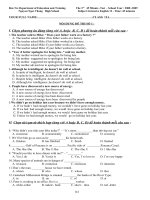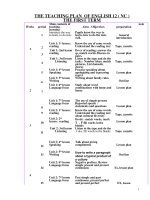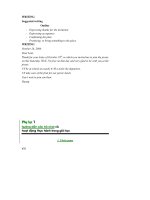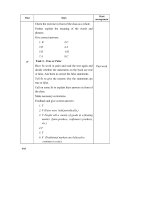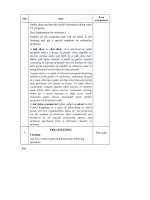Unit 1. Tiếng Anh 12 nâng cao
Bạn đang xem bản rút gọn của tài liệu. Xem và tải ngay bản đầy đủ của tài liệu tại đây (136.52 KB, 15 trang )
Week 1
REVIEW
Period 1
I. Objective : By the end of the lesson, SS will be able to revise and use some grammar points
and vocabulary items ( Tieng Anh 11 – nang cao ) appropriately and know how to use the book
Tieng Anh 12 – nang cao.
II. Materials : Textbook, …
III. Procedure :
1. Class control : (2’)
- Greeting and taking attendance
2. Checking the previous lesson :(X )
3. Today’s lesson :
Teacher’s & Students’
activities
Content Stages / timing
_ T helps Ss revise some
vocabulary items, grammar
points, …
- Ss pay attention and reply,
answer the teacher’s
questions.
- T gives some examples
and asks Ss to practices the
points.
- T tells Ss to take notes for
later review.
I. Từ vựng : ( Word Study )
1. Ôn tập các chủ điểm từ vựng từ Unit 1 đến Unit 16 cụ
thể là :
* Tính từ miêu tả ( descriptive adjectives ) : thứ tự vò trí của
tính từ miêu tả
* Thành lập danh từ kép ( compound nouns : noun + noun )
* Tính từ thành lập từ động từ ( V+ed / V+ing )
* Tính từ thành lập từ danh từ ( N + ful / al / able / ous )
* Danh từ thành lập từ động từ ( V + ment / al / ion / ation /
ance – chỉ hoạt động )
( V + er / or / ant / ee – chỉ người )
* ( cách viết phân số – Fractions)
2. Ôn tập chủ điểm từ vựng của các đơn vò bài học ( Units
1- 8 – SGK )
* Unit 9 : phân biệt hậu tố “-al” ( danh từ // tính từ )
* Unit 10 : thành lập từ với tiền tố “bio –“
* Unit 11: Danh từ kép được thành lập từ cụm động từ
( phrasal verbs ))
* Unit 12 : phân biệt cấu tạo các từ loại ( word derivation )
* Unit 13 : từ ngữ liên quan đến chủ điểm Giải trí
( entertainment )
* Unit 14 : danh từ kép với space / air
* Unit 15 : tính từ kép với “well –“
2. Ôn tập chủ điểm từ vựng của các đơn vò bài học ( Units
1- 16 – SGK ) : nature in danger, energy sources, Asian
Games, hobbies, entertainment, space conquest…
II. Ngữ Pháp – Cấu trúc ( Grammar & structure )
Cách chia và sử dụng các thì (verb tenses)
Phân biệt các dạng của động từ ( verb forms : V-ing / V /
to-V ) : Units 1, 2, 3, 4
Câu nói tường thuật dạng mệnh lệnh, đề nghò, khuyên,
Presentation
40’
1
xin lỗi , cám ơn ( Reported speech)
Phân biệt cách sử dụng Gerund / perfect gerund; present
participle/ perfect participle
Biết rút gọn mệnh đề liên hệ, lí do, nhượng bộ, điều kiện,
thời gian …dùng cụm từ hiện tại phân tự ( present participle
phrases )
Phân biệt mệnh đề liên hệ xác đònh và không xác đònh
(restrictive & non-restrictive )
Tường thuật câu điều kiện ( indirect speech with
conditional sentences )
Mệnh đề liên hệ rút gọn ( reduced relative clause ) Unit 9
Relative clauses with preposition : unit 10
Relative pronouns // Omission of relative pronouns : unit
11
Câu chẻ ( cleft sentences ) // Câu chẻ bò động : Units 12, 13
Cấu trúc song song ( parallel structures ) : both …and…, not
only…but also…, either…or…, neither…nor… : Units 12, 13
Sự hòa hợp chủ ngữ và động từ : Unit 13
Phân biệt CAN, COULD, BE ABLE TO : Unit 14
Câu bò động dạng đặc biệt : Unit 15
Câu điều kiện : Unit 16
III. Đọc hiểu ( reading )
Chủ điểm các bài đọc từ Unit 9 đến Unit 16( SGK).
Kỹ năng làm các dạng bài tập đọc hiểu sau đây :
+ Đọc và trả lời câu hỏi.
+ Đọc và đánh dấu ( ) True / False
+ Đọc và chọn đáp án đúng cho mỗi câu hỏi.
IV. Viết ( Writing )
Chuyển đổi câu (sentence transformation )
Viết đoạn văn
Viết thư mời ( writing a letter of invitation ) : Unit 3
Viết thư nhận lời / từ chối ( writing a letter of acceptance /
refusal ) : Unit 3
Viết thư cám ơn (writing a thank-you letter ) : Unit 4
Viết đoạn văn miêu tả biểu đồ ( writing a paragraph to
interpret a graph ) : Unit 6
Viết thư phàn nàn ( writing a letter of complaint) : Unit 8
Miêu tả biểu bảng ( Describing tables )
Miêu tả đòa danh ( Describing a place )
Miêu tả sở thích ( writing about hobbies
Viết tiểu sử ( writing a biography )
4. Wrapping- Homework : ( 3’)
- T summarizes the main points and assigns homework
IV. Comments :
Week 1
Unit 1 : HOME LIFE
Period 2
READING 1
2
I. Objective : By the end of the lesson, SS will be able to
- get some more knowledge about home life.
- use vocabulary items related to “home life”.
II. Materials : Textbook, pictures of domestic chores…
III. Procedure :
1. Class control : (2’)
- Greeting and taking attendance
2. Checking the previous lesson :( x )
3. Today’s lesson :
Teacher’s & Students’ activities Content Stages / timing
- T lets Ss look at the pictures of
domestic chores and work in pairs
to study the pictures.
- Ss discuss what people in the
pictures doing.
- T has Ss give their ideas.
- T gives feedback and leads Ss in
the lesson.
- T gets Ss to read the sentences and
check the suitable boxes.
- T asks Ss to practice asking and
answering
which domestic chores do you do ?
- T has Ss give feedback.
- T introduces the text and asks Ss to
read it silently.
- T elicits new vocabulary and
explains new words and phrases.
- T checks vocabulary : What and
Where.
Task a) Pairwork
A. là (ủi) quần áo (ironing clothes )
B. lau sàn nhà ( mopping the floor )
C. tưới cây (watering plants )
D. phơi quần áo ( air-drying the laundry
Task b) Individual work
T F
1. Making your bed
2. Washing dishes
3. putting dirty clothes in the laundry
4. Cleaning room
5. Watering flowers and plants
6. Buying food for the family
7. Collecting and disposing garbage
8. Folding laundry
Vocabulary Preteach
1. to peer through: trố mắt nhìn vào
2. to glare: nhìn tức tối
3. dismayed (adj.): bực dọc, bất mãn
4. nightly (adj.) (xảy ra) vào ban đêm
5. conflict (n.) xung đột
6. (be) bewildered (adj.) bối rối
7. to sit cross–legged: ngồi bắt tréo chân
8. (be) shocked: (adj.) sửng sốt
9. messy: bừa bộn, rối tung mess (n.)
10. disgusted glare: ánh mắt
11. to nag: la rầy; cằn nhằn
12. to go wrong: hỏng bét
13. responsibility: trách nhiệm
14. to respond: đối đáp, đáp lại
15. devastating (adj.): gây sửng sốt
16. contemporary (adj.): đương thời
Warm-up
5’
Pre-reading
10’
25’
3
17. to divvy up: divide something into small parts
18. pragmatic aspect: khía cạnh thực tiễn
19. dynamics: tính năng động
20. sociologist: nhà xã hội học
4. Wrapping- Homework : ( 3’)
- T summarizes the main points and assigns homework
IV. Comments :
Week 1
Unit 1 : HOME LIFE
Period 3
READING 2
I. Objective : By the end of the lesson, SS will be able to
- scan for specific information / details.
- improve their reading skill through Matching, Answering Questions exercises
II. Materials : Textbook, pictures of household chores,…
III. Procedure :
1. Class control : (2’)
- Greeting and taking attendance
2. Checking the previous lesson :( 8’)
Read the sentences. Fill in the blanks with suitable words from the box
a. Virginia shouted to her teenage daughter as she ……………through the bedroom door.
b. The daughter was sitting …………………………on the floor.
c. Washing dishes, cleaning rooms and making your bed are household…………………
d. Blair looks at specific roles within family structure and at how families……………up domestic
chores.
e. Twenty five percent of responding parents admitted that they constantly …………their children
about cleaning their rooms.
Answer key :
a. peered; b. cross-legged; c. chores; d. divvy; e. nag
3. Today’s lesson :
Teacher’s & Students’ activities Content Stages / timing
- T divides Ss into 2 teams and instructs
the game.
- T mimes and Ss try to write down what
the teacher says.
- T checks and declares the winning team
MIMING
1. Making your bed
2. Washing dishes
3. putting dirty clothes in the laundry
4. Cleaning room
5. Watering flowers and plants
6. Buying food for the family
7. Collecting and disposing garbage
Warm-up
5’
peered cross-leged divvy chores nag
4
- T asks Ss to read the text again and do
task b ( p.16 ) independently
- T calls on Ss to give their answers. T
comments and gives correct answers.
- T asks Ss to read the text carefully and
find answers to the questions.
- T has Ss cross-check their answers with
a partner.
- T calls on Ss to write down their
answers on the board.
- T invites class opinion and gives correct
answers.
- T lets Ss practice asking and answering
the questions in pairs.
- T put the class into pairs again and asks
Ss to prepare a two-minute oral
presentation of what problems they often
have with their parents over household
chores.
- Ss discuss in pairs and write an outline.
- T calls on some Ss to present in front of
the class.
- T listens , takes notes for later
correction.
8. Folding laundry
Task b) Match each item in column A with its
corresponding meaning in column B.
KEY: 1. c – 2. e – 3. d – 4. b – 5. f – 6. a
Task a) Answer the following questions
Expected answers:
1. Their children often neglect their duty on
household chores such as cleaning their rooms,
clearing the table after meals, or hanging up
wet towels.
2. She complained that she used to do twice as
much domestic chores as her daughter did.
3. Most American children contribute to the
household chores at some level, e.g. some 6–8–
year–old children contribute 12 percent of all
household labor.
Task c) Pairwork :Oral Preparation.
How many people are there in your family ?
Who is the householder ?
What is he / she like ?
What do you have to do every day ?
Do your parents often nag you ?
Suggested answers:
I live in a family of five members: my
father, my mother, my two brothers (sisters)
and myself.
My father is the householder, but he is an
indecisive person in dealing with my mother’s
assigning us to do house chores. What I have to
do is to clean the floor and windows every day.
Also, I have to dump the garbage and wash the
dishes after meals. Because I am so keen on
TV that I, once in a while, forget my duty,
which often upsets my mother. She never lets
bygones be bygones and nags me into what I
have to do.
While – reading
5’
10’
Post -reading
12’
4. Wrapping- Homework : ( 3’)
- T summarizes the main points and assigns homework
IV. Comments :
Week 1
Unit 1 : HOME LIFE
Period 4
LISTENING
5
I. Objective : By the end of the lesson, SS will be able to
- listen for specific information related summer household chores.
- improve their listening skill through ordering ideas exercise.
II. Materials : Textbook, cassette player,…
III. Procedure :
1. Class control : ( 2’)
- Greeting and taking attendance
2. Checking the previous lesson :( 8’)
Answer the following questions.
a. What percentage of responding parents admitted that they constantly nag their children ?
b. What did Virginia complain about her daughter over domestic chores ?
c. What other tasks are mentioned in the text ?
Key : a. 25 %
b. She complained that she used to do twice as much house chores as her daughter did.
c. Picking up dirty clothes, returning soiled dishes to the sink, hanging up wet towels…
3. Today’s lesson :
Teacher’s & Students’ activities Content Stages / timing
- T introduces and conducts Kim’s
Games. T puts Ss into 2 teams.
- T lets Ss look at the pictures on page
17.
- Ss remember and write down as many
things as possible with their books closed.
- T declares the winner and introduces
the lesson.
- T puts Ss in pairs again and asks them
to match each picture with the
corresponding description.
- T has Ss give their answers and gives
feedback.
- T plays the tape more than once and
lets Ss do the task
- T asks Ss to compare their answers with
a partner.
- T lets Ss speak out their answers
- T gives comments.
- T asks Ss to work in groups of 4 and
KIM’S GAME
Expected answers :
- shoe
- dog
- vacuum cleaner
- pot
- window
Task a) Pairwork : Matching.
Picture A: a walking toddler
Picture B: feeding
Picture C: vacuuming
Picture D: cleaning
Task b) Listen and number the ideas in order.
KEY
Feeding and watering pets
Cleaning floors and carpets
Sweeping and mopping floors
Vacuuming
Cleaning spots on carpets
Watering lawns and plants
Cleaning windows and sliding glass doors
Spraying window cleaner
Wiping windows
Warm-up
5’
Pre–listening.
5’
While Listening.
15
6
